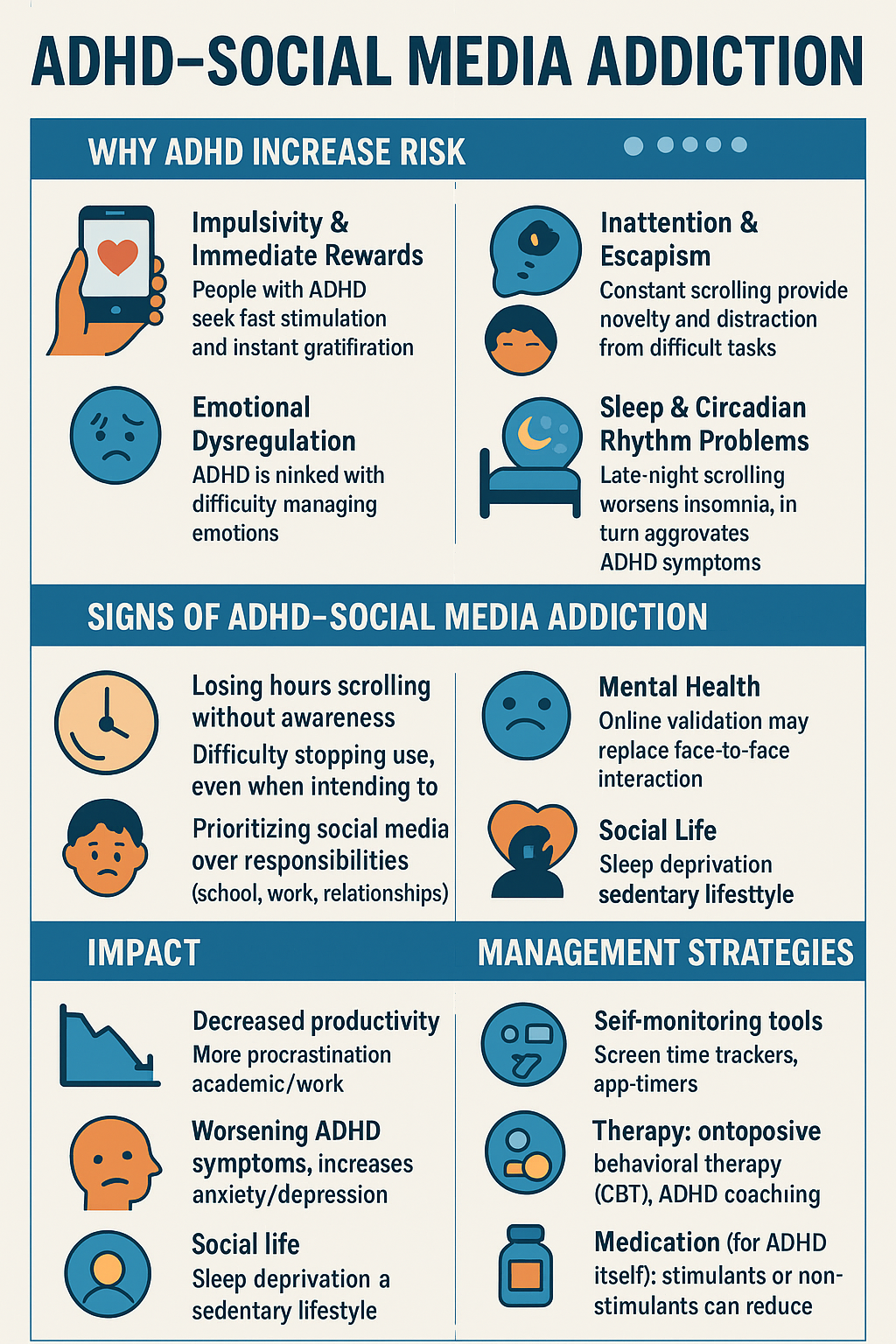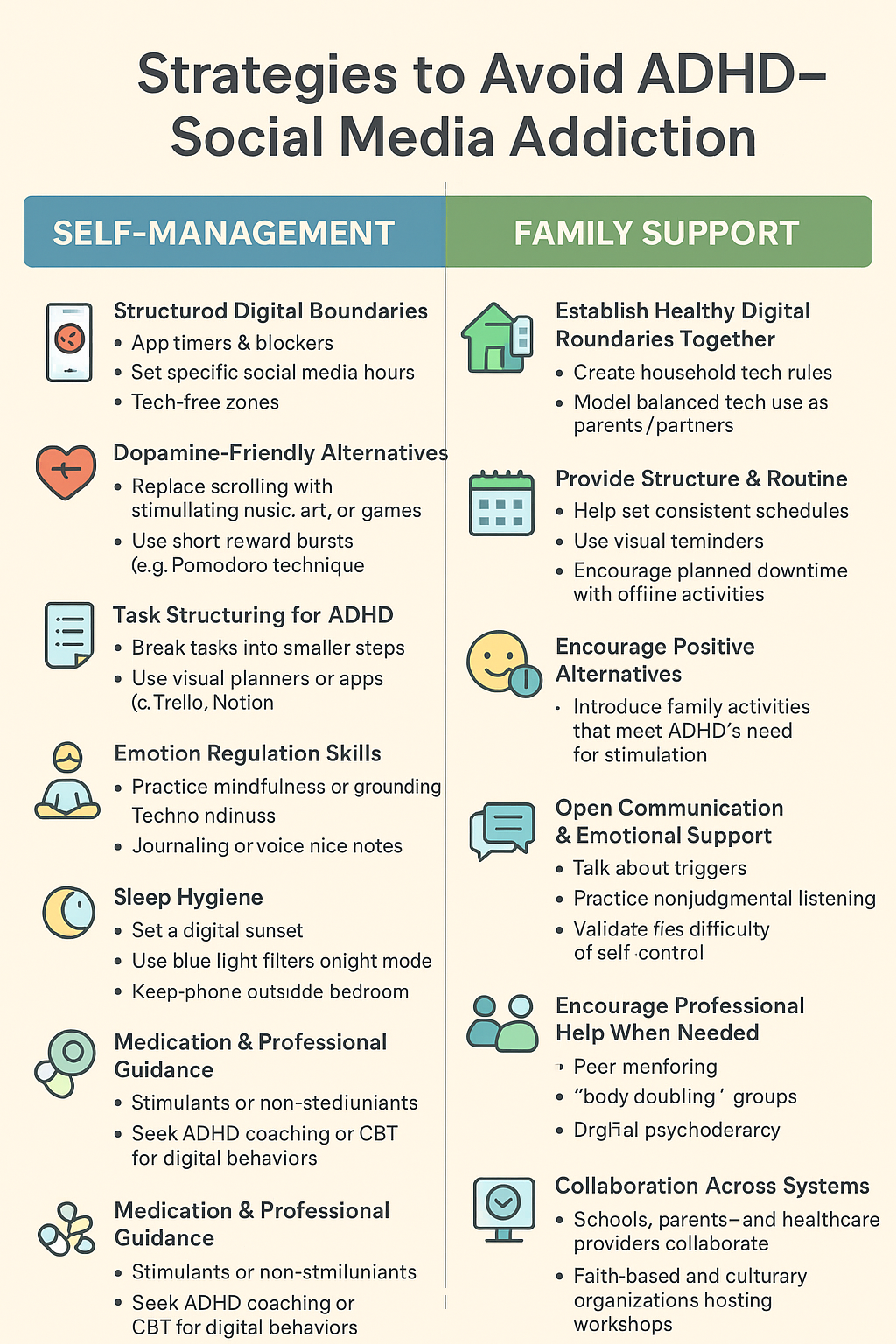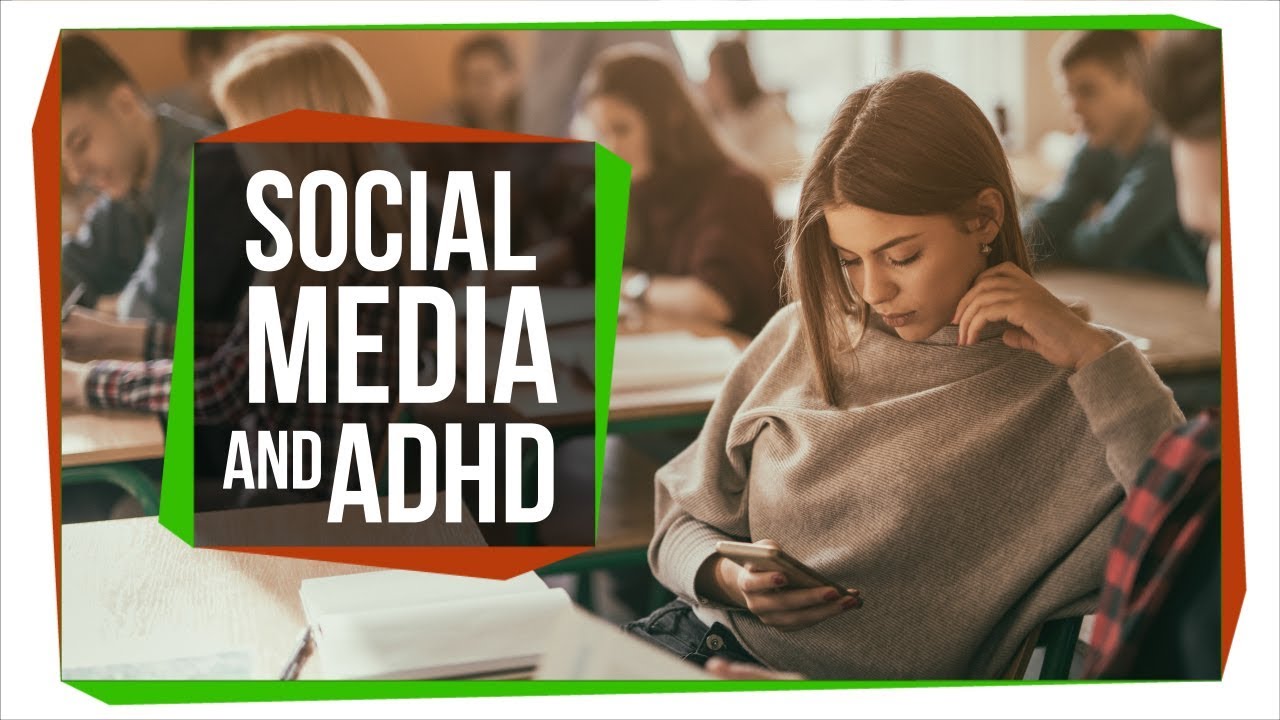ADHD–social media addiction symptoms are impulsivity, heightened reward-seeking, and difficulties with self-control, which make individuals more prone to excessive online use. Prevention combines self-management strategies like routines and screen limits, family support through structure and guidance, and community resources such as support groups, helping individuals build healthier digital habits and resilience.
ADHD–Social Media Addiction: Understanding the Connection
This refers to the interaction between Attention-Deficit/Hyperactivity Disorder (ADHD) and problematic or addictive social media use. While not an official diagnosis (such as in the DSM-5), it is a descriptive term often used in research and clinical discussions to explain why ADHD symptoms make individuals more vulnerable to social media addiction.
Why ADHD Increases Risk
- Impulsivity & Immediate Rewards
- People with ADHD often seek fast stimulation and instant gratification.
- Social media platforms are designed with “variable reward systems” (likes, comments, notifications) that strongly activate the brain’s dopamine reward pathway—similar to gambling.
- Inattention & Escapism
- Constant scrolling provides novelty and distraction from boring or difficult tasks.
- For someone with ADHD, this can feel like relief from struggles with focus, organization, or academic/work demands.
- Emotional Dysregulation
- ADHD is closely linked with challenges in managing emotions.
- Social media can become a coping tool for stress, loneliness, or rejection, reinforcing compulsive use.
- Sleep & Circadian Rhythm Problems
- Many with ADHD already face sleep difficulties.
- Late-night scrolling worsens insomnia, which in turn aggravates ADHD symptoms, creating a vicious cycle.
Signs of ADHD–Social Media Addiction
- Losing hours scrolling without realizing it.
- Difficulty stopping use, even with intention.
- Prioritizing social media over responsibilities (school, work, relationships).
- Feeling anxious, irritable, or bored when offline.
- Experiencing sleep disruption and daytime fatigue.
Impact
- Academic/Work: More procrastination, reduced productivity.
- Mental Health: Worsens ADHD symptoms, raises risk of anxiety and depression.
- Social Life: Online validation may replace in-person connections.
- Physical Health: Poor sleep, sedentary habits, fatigue.
Management Strategies
- Self-monitoring tools: Screen time trackers, app timers.
- Behavioral strategies: Structured routines, scheduled offline breaks, “dopamine fasting.”
- Therapy: Cognitive-behavioral therapy (CBT), ADHD coaching, digital detox approaches.
- Medication: ADHD treatment (stimulants or non-stimulants) can reduce impulsivity and indirectly lessen addictive behaviors.
👉 In short: ADHD–Social Media Addiction isn’t an official disorder, but it captures how ADHD symptoms—impulsivity, reward-seeking, and inattention—interact with the highly stimulating design of social media, making individuals especially vulnerable to compulsive use.
Self-Management Strategies for ADHD–Social Media Addiction
Self-management strategies are a cornerstone in addressing ADHD-related social media addiction, since individuals must learn to regulate their own attention and impulses in daily life. By building routines, setting digital boundaries, and practicing mindfulness or focus techniques, people with ADHD can gain more control over their screen use. These strategies not only help reduce excessive online engagement but also strengthen executive functioning skills, allowing individuals to create healthier digital habits and maintain balance in their personal, academic, and social lives.
Here are some evidence-based self-management strategies to help avoid or reduce ADHD–Social Media Addiction:
1. Structured Digital Boundaries
- App timers & blockers: Use tools like Freedom, Forest, or built-in screen time settings.
- Set “social media hours”: Allocate specific time slots instead of unrestricted access.
- Tech-free zones: No phone use in bed, during meals, or study/work sessions.
2. Dopamine-Friendly Alternatives
- Replace scrolling with stimulating but healthier activities: exercise, music, art, or games that provide novelty without the endless feed.
- Use short reward bursts: For example, after 25 minutes of focused work, reward yourself with 5 minutes of a fun activity (Pomodoro technique).
3. Task Structuring for ADHD
- Break tasks into smaller, manageable steps to reduce boredom and overwhelm.
- Use visual planners or apps (Trello, Notion, or even a physical whiteboard) to create external structure and reminders.
4. Emotion Regulation Skills
- Practice mindfulness or grounding (like the 5-4-3-2-1 sensory method) when the urge to scroll hits.
- Try journaling or voice notes to process emotions instead of escaping online.
5. Sleep Hygiene
- Create a digital sunset: stop screen use 30–60 minutes before bed.
- Use blue light filters or night mode in the evening.
- Keep your phone outside the bedroom to prevent “doom scrolling.”
6. Accountability & Social Support
- Share your goals with a friend, ADHD coach, or support group for accountability.
- Try body doubling—working alongside someone in person or virtually—to reduce distraction and stay on track.
7. Medication & Professional Guidance
- If ADHD is untreated, stimulant or non-stimulant medication may reduce impulsivity and improve focus, making it easier to regulate social media use.
- ADHD coaching or CBT (Cognitive Behavioral Therapy) can help reinforce healthier digital habits and routines.
👉 The key is replacing unstructured, impulsive use with intentional, rewarding alternatives—so the brain’s need for stimulation is met without falling into endless scrolling.
Family Support Strategies to Prevent ADHD–Social Media Addiction
Families play a vital role in helping individuals with ADHD manage the risks of social media addiction. Because ADHD often involves challenges with impulsivity, attention regulation, and self-control, family members can provide structure, guidance, and accountability that strengthen healthier habits. Through clear boundaries, consistent routines, and supportive communication, families create a safe environment where individuals with ADHD can learn to balance technology use while building skills for focus and emotional regulation.
1. Establish Healthy Digital Boundaries Together
- Create household tech rules (e.g., no phones at dinner, bedtime cutoff).
- Model balanced tech use as parents/partners—show that family time comes before screen time.
2. Provide Structure & Routine
- Set consistent daily schedules (study, chores, social media breaks).
- Use visual reminders (whiteboards, sticky notes, shared calendars).
- Encourage planned downtime with offline activities like exercise, games, or hobbies.
3. Encourage Positive Alternatives
- Introduce family activities that meet ADHD’s need for stimulation (sports, art, cooking).
- Offer reward-based motivation: complete responsibilities first, then earn limited social media time.
4. Open Communication & Emotional Support
- Talk about triggers (stress, boredom, rejection) that fuel scrolling.
- Practice nonjudgmental listening—avoid shaming or punishing for screen struggles.
- Validate the difficulty of self-control with ADHD instead of framing it as laziness.
5. Shared Accountability
- Use apps with family-linked screen time monitoring to encourage healthy limits.
- Try digital detox challenges as a family activity—not as punishment.
- Check in on goals weekly, celebrating small wins together.
6. Encourage Professional Help When Needed
- Support attendance at ADHD therapy or coaching sessions.
- Join family psychoeducation programs to better understand ADHD and digital behavior.
- Encourage adherence to treatment plans (medication, therapy) that improve impulse control.
👉 In short: Families can help by providing structure, modeling balance, encouraging offline activities, and supporting emotional regulation instead of simply restricting access.
Community Resource Strategies for ADHD–Social Media Addiction
Community resources are essential in supporting individuals with ADHD who are vulnerable to social media addiction. Beyond the home, schools, local organizations, healthcare providers, and peer networks can provide structured opportunities, education, and accountability. By offering digital literacy programs, extracurricular activities, support groups, and mentorship, communities create environments that reduce reliance on screens while promoting healthier, more engaging alternatives. These collective efforts not only address the unique challenges of ADHD but also build resilience and social connection.
Community Resource Strategies for ADHD–Social Media Addiction
1. ADHD & Mental Health Support Programs
- ADHD support groups (in-person or online) where members share coping strategies and accountability.
- Community mental health centers offering therapy groups that teach emotion regulation and digital wellness skills.
- ADHD coaching workshops hosted by local nonprofits or organizations.
2. Digital Wellness & Education Campaigns
- Schools, libraries, or youth centers can host digital literacy workshops that explain how social media’s design and dopamine reward systems impact attention.
- Public awareness campaigns that frame screen balance as a health issue, not just a personal failing.
3. Structured Extracurricular Activities
- Encourage participation in sports, arts, clubs, or volunteering to provide stimulating, structured alternatives to screen time.
- Community centers can offer low-cost programs that engage attention and reward pathways in healthier ways.
4. Peer & Mentorship Programs
- Peer mentoring: older students, coaches, or trained mentors guiding young people with ADHD in setting tech boundaries.
- Body doubling groups (coworking or study spaces) to reduce distraction and create accountability.
5. Technology-Based Supports
- Communities can provide access to apps or tools that help manage ADHD and digital use (e.g., focus apps, parental controls, productivity platforms).
- Local libraries or schools can run digital detox challenges where participants track screen time reductions together.
6. Collaboration Across Systems
- Schools, parents, and healthcare providers can collaborate on structured support plans for students struggling with ADHD and tech overuse.
- Faith-based and cultural organizations can host workshops blending community values with digital wellness education.
- Employers can provide workplace wellness programs addressing ADHD and tech overuse in adults.
👉 In summary: Community strategies are most effective when they combine education, structured activities, peer support, and accessible mental health resources—giving people with ADHD stimulating alternatives and accountability outside the home.
Frequently Asked Questions
Here are some common questions:
Question: Provide a visual infographic-style breakdown about ADHD-Social Media Addiction.
Answer: ADHD-Social Media Addiction Flyer.

Question: Provide a combine the self-management, family, and community strategies into one large infographic about ADHD-Social Media Addiction.
Answer: Strategies to avoid ADHD-Social Media Addiction.

Question: How can social media induce ADHD symptoms to its subscribers?
Answer: How Social Media Can Trigger ADHD-Like Symptoms
- Constant Novelty & Reward
- Effect: Short attention span, frequent checking
- Example: Scrolling TikTok and getting sudden viral videos triggers quick dopamine hits, making users crave constant updates.
- Fragmented Attention
- Effect: Difficulty focusing on one task
- Example: A student tries to study but keeps switching between Instagram, YouTube, and messages.
- Impulsivity Reinforcement
- Effect: Quick, unplanned reactions
- Example: Posting or commenting impulsively to get immediate likes or feedback.
- Sleep Disruption
- Effect: Worsened inattention, irritability, emotional dysregulation
- Example: Late-night scrolling delays sleep, making it harder to concentrate the next day.
- Overstimulation
- Effect: Difficulty concentrating, hyper-responsiveness
- Example: Flashy videos, sounds, and notifications overwhelm the senses, making sustained focus harder.
Bottom Line: Social media’s design—constant rewards, rapid updates, and sensory overload—can mimic or amplify ADHD symptoms, even in users without a diagnosis.
Conclusion
ADHD–social media addiction is a growing concern, but it can be prevented with the right strategies. By practicing self-management skills, families providing structure and encouragement, and communities offering supportive resources, individuals with ADHD can build healthier digital habits. When these levels of support work together, they create a stronger foundation for balance, focus, and well-being in a world where social media is ever-present.
